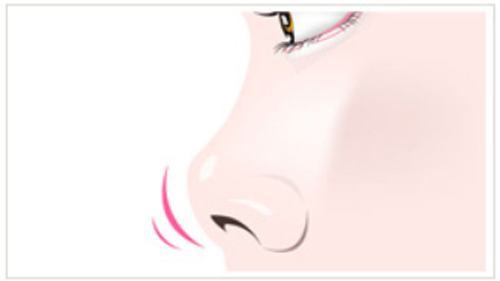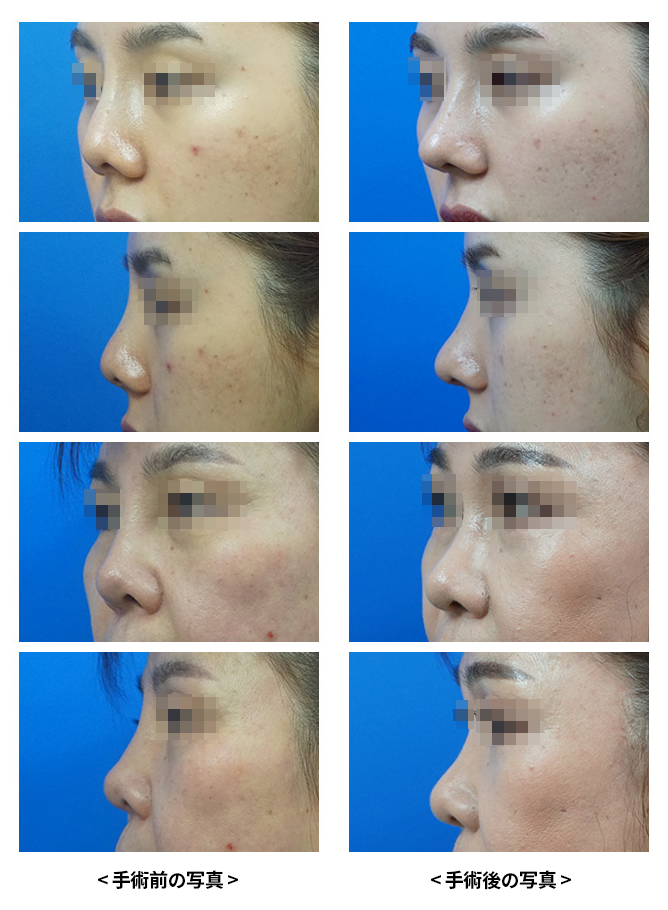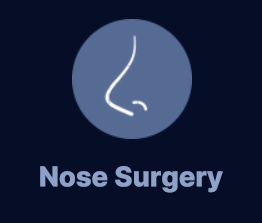

What is Nose Revision Surgery?
We accurately identify the cause and use 20 years of expertise and technology in nose revision surgery to correct and repair your nose at KOKO.
**Surgery Time:** 2-3 hours
**Anesthesia:** Sleep Anesthesia
**Hospitalization:** Not Required
**Suture Removal:** 4-6 days
**Recovery Period:** 7 days
Candidates
1.When the silhouette of the nasal implant is prominent, clearly indicating that nasal surgery has been performed.
2.When the width of the nasal bridge is too narrow or the height is too high.
3.When the nasal tip becomes deformed.
4.When the nasal tip becomes lower.
5.When the nose becomes shorter after surgery.
6.When the nasal tip becomes pointed and the skin becomes thin.
7.When the nose is crooked.
8.When the nasal bridge or tip becomes red.
9.When the implant moves or becomes visible.
What is a revision rhinoplasty?
A revision rhinoplasty refers to a subsequent surgery performed when the desired outcome of a previous nose surgery is not achieved, or when functional issues arise. Typically, revision surgery is considered when there are complications such as the nose taking on a different shape than desired. It is considered when there is excessive movement of implants, overly pointed nasal tip, nasal collapse, or inflammation occurring after the initial surgery.
It’s more complex than the first surgery and should be done by an experienced rhinoplasty specialist.
When to have a revision rhinoplasty
It is advisable to wait at least six months following the initial surgery before undergoing revision rhinoplasty.
However, if the adjustments required are minimal, such as those to the nasal bridge, a revision may be considered as soon as three months post-operation. Typically, nasal tissues take about six months to stabilize after the first surgery. Since the ideal timing for a revision varies from individual to individual, consulting a specialist is highly recommended.
WHY KOKO?
1. You will receive personalized, one-on-one consultation and accurate diagnosis, leading to highly satisfactory results.
2. A comprehensive analysis of the causes of nasal problems and detailed procedures is crucial. With years of experience and know-how, we accurately identify the causes of issues and provide appropriate treatments.
3. We bring over 20 years of expertise in revision surgeries.
4. With 20 years of experience and know-how, Dr. Cho, who specializes in plastic surgery, offers direct consultations and performs surgeries.
Revision surgery for a deviated nose after rhinoplasty
If the implant itself becomes bent and the nose remains deviated without correcting the original deviation, then revision surgery is necessary.
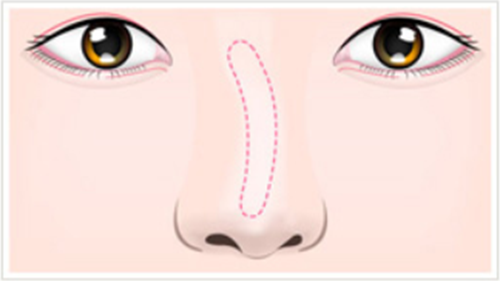
If the implant becomes bent
If the implant becomes bent or changes shape over time, a revision surgery will be performed to reposition the implant.
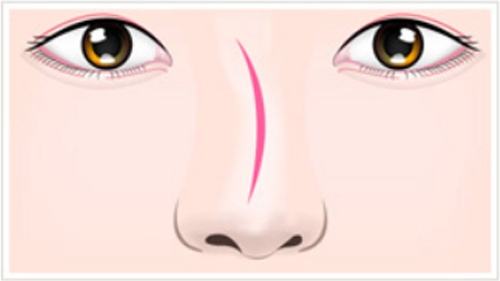
If the original bridge is crooked
The revision surgery will involve removing the implant, correcting the bent nose, and resolving any deviated septum issues.
The revision surgery for a noticeable nose after rhinoplasty
If the rhinoplasty results in an overly prominent nose, it may not complement the overall balance of the face. Additionally, if the bridge of the nose is too high or the tip is overly pointed, it can cause the nose to stand out disproportionately, further affecting facial harmony. As a result, if dissatisfaction arises, a revision rhinoplasty may be necessary.
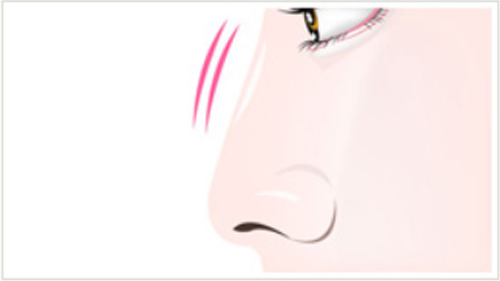
If the nasal bridge is too high
The nasal bridge is higher compared to the balance of the face and it’s evident that surgery has been performed. The existing implant is removed, and an implant that matches the facial balance is used. During this process, the height of the nasal bridge and the contour of the nasal tip are balanced to create a natural-looking nose.

If the nasal tip is too high
The implant inserted in the nasal tip is removed, and a revision surgery is performed using materials such as nasal septal cartilage, ear cartilage, or AlloDerm.
During this procedure, a natural and aesthetically pleasing nasal tip is reconstructed to complement the nasal bridge. In some cases, a revision surgery of the nasal bridge may also be conducted.
Revision surgery for a collapsed nasal tip
If the nasal tip was not adequately supported during previous nasal surgery, the nasal tip may collapse. In such cases, a revision surgery is performed to correct the tip using soft and sturdy materials such as septal cartilage or artificial bone.
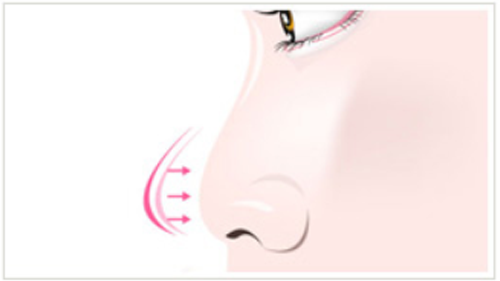
Bulbous nose after nasal surgery
If during the initial surgery, the subcutaneous fat at the tip of the nose is not adequately removed or wide cartilage is transplanted, it may result in a bulbous nose. In such cases, the subcutaneous fat is removed while preserving the necessary amount, and narrow cartilage is transplanted to create a natural and refined nasal tip.
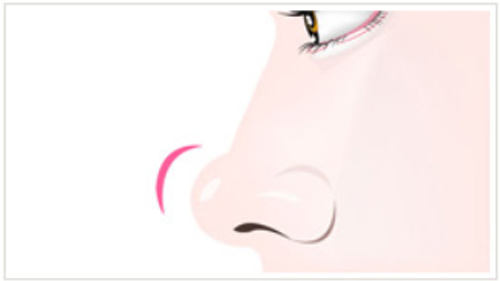
The implant is not properly secured
When the implant cannot be placed under the periosteum of the nasal bone and is instead inserted directly under the skin layer, it becomes unstable and moves. In such cases, a space is created under the periosteum to reposition the implant.

Thinning skin
If the implant is too thick and doesn’t match the contour of the nasal bone, it can cause thinning of the skin, leading to the implant becoming visible and the nasal bridge turning red. If the nasal bridge becomes red, prompt consultation with a specialist and treatment is necessary.
In cases of thinning skin, the length and height of the implant are readjusted, and the nasal tip is supplemented using materials such as ear cartilage or AlloDerm.
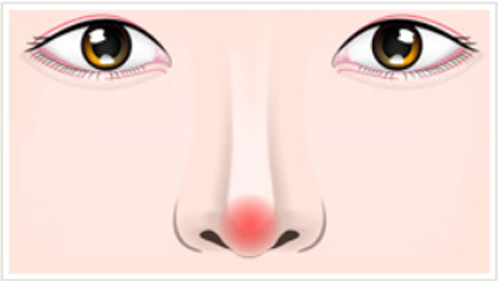

Deviated nostrils
Revision surgery for collapsed nostrils occurs when the nasal tip and alar are concave, obstructing the entrance to the nostrils, typically due to excessive damage or tearing of the alar cartilage. In such cases, a revision surgery using alar cartilage grafting is performed to correct the deviated nostrils.
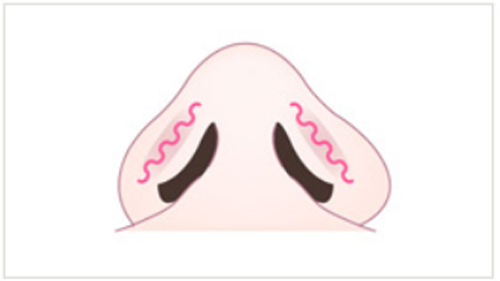
Asymmetry of the nostrils
If the asymmetry of the nostrils persists after surgery or if the balance between the nasal septal cartilage and nasal alar cartilage is disrupted due to surgery, a revision surgery using nasal alar cartilage technique is performed to correct the asymmetry of the nostrils.
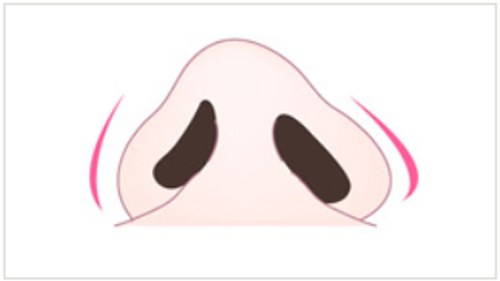
Uncorrected hooked nose
If nose surgery is performed without correcting the hooked nose, it may recur or remain. Conversely, excessive excision can lead to indentations or deformities. In the event of a recurrence of the hooked nose, the protruding area is trimmed. Additionally, if there has been excessive excision, revision surgery using cartilage is performed.
Nasal inflammation
After nasal surgery, the likelihood of inflammation is very low, but it can occur due to ill-fitting implant or other infections.
In particular, inflammation caused by hematoma that persists for a long time after nasal surgery can cause pain and lead to pus and blood in the nasal cavity. Prompt consultation with a specialist is necessary, along with the possibility of revision surgery.
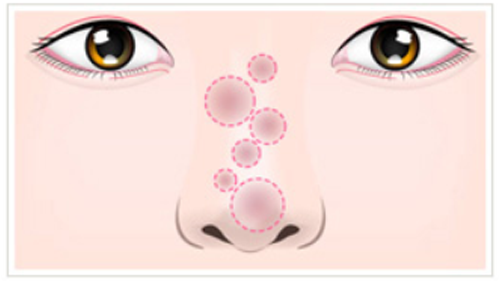
Inflammation in the nose requires prompt treatment
If inflammation occurs in the nose, treatment for inflammation is conducted first before removing the implant. Then, as a replacement for the implant, ‘autologous rib cartilage’ or ‘nasal septal cartilage’ is utilized for the revision surgery. Autologous rib cartilage or nasal septal cartilage is harvested from your own body and is relatively low in rejection reactions.
Case photos of nasal revision surgery
What is a contracted nose?
Contracted nose is one of the serious complications of rhinoplasty, and it represents a relatively challenging case.
It occurs when inflammation occurs after nasal surgery and is left untreated in the early stages, or when nasal surgeries are performed frequently. Contracted nose (or nasal contraction) refers to the condition where scars inside the nose cause it to become stiff and contract. During this time, the nasal tip may be lifted, shortened, or the implant may collapse, resulting in a distorted nose.
